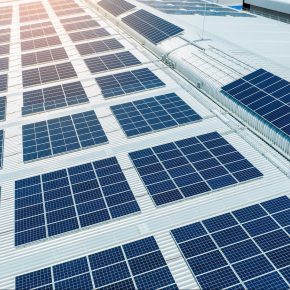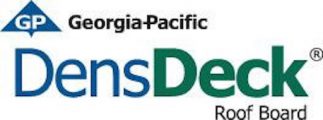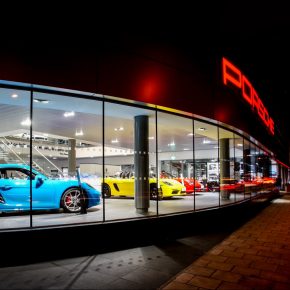
DensDeck: Solar Panel Roofing for Mission Critical Buildings
The risk of solar panel roof related fire on mission-critical buildings can be mitigated by first understanding the root causes of outbreaks of fire and then adopting an appropriate strategy to minimise the frequency of such events occurring. DensDeck has more…
The presence of a solar panel on, for example, a data centre flat roof, introduces extra electrical equipment to the roof. It joins the other plant already highly likely to be positioned there, typically for air conditioning and ventilation, which is essential for the smooth running of a datacentre. Whenever electrical equipment is installed on a roof, it brings with it the possibility of being responsible for the outbreak of a fire if the equipment malfunctions.
For so called ‘mission critical’ buildings, such as data centres, biotech facilities and airports, the overriding objective is to ensure that operational downtime is minimised so that the vital services they provide are available 24 hours a day, 365 days a year.
This requires a roof specification that can help reduce the risk when it comes to a variety of challenges, these include extra weight in the roof, additional maintenance foot traffic, protection from ad hoc events that could cause mechanical damage to the roof membrane and, of course, the risk of an outbreak of fire.

Mission critical buildings’ solar roofs are increasingly specified to provide a renewable energy source for energy intensive processes. Solar roofs reduce the intensity of building’s reliance on the electricity grid, lower its carbon dioxide (CO2) emissions and reduce energy costs. The advantages of solar panel flat roofs are clear; however, the increase in the possibility that a fire may occur needs to be recognised and mitigated.
What is the most likely cause of an outbreak of a fire on a mission critical building solar roof?
Analysis of solar panel roofs shows that high temperatures in excess of 6,000 °C created by electrical arcing1 in faulty PV systems are the most likely cause of an outbreak of fire on a mission critical building’s solar roof. Electrical arcing happens when conducting parts of the components that make up the solar panel flat roof system become separated.
An electrical current flows between the separated parts by ionising the air in between them and, as the current is direct (DC), rather than alternating (AC), the arc can be sustained. The high temperature created can cause parts of the PV system, or nearby waterproof membrane, to combust and the fire to spread across the roof.
Building Research Establishment (BRE), on behalf of the government, carried out a survey2 to determine which components of the PV system were most likely to experience arcing. DC isolators posed the greatest risk followed by DC connectors, inverters and then the PV modules themselves. The survey went on to investigate what caused these arcing issues to develop and poor installation practices were responsible for over a third of the instances recorded, followed by system design errors and faulty products.
How can the causes of fires on mission critical building solar roofs be addressed?
A focus on careful handling of PV systems during transportation and installation to avoid equipment damage that could lead to electrical arcing is a good practice to follow for solar panel flat roofs. Ensuring that good installation practices, in line with manufacturer’s instructions, are employed by using trained and experienced operatives will help also help reduce instances of arcing.
Selecting a proven solar panel system design with a good track record for reliability can help to mitigate against the risks of manufacturers defects.
There are also products that can be specified as part of the system to add extra layers of safety. They enclose key connections with casings that will protect materials around them should arcing occur.
It is also important to carry out regular maintenance and inspection of the solar panel roof once it is installed. This will ensure no damage or wear to the system has occurred that could allow the ingress of moisture leading to electrical faults. The maintenance should include cleaning of any electrical contacts that have a build-up of oxide contaminants as these can lead to increased temperature in those areas and may lead to arcing.
What is the probability that a fire will occur on a mission critical building solar roof?
With regards to the probability that a fire will occur on a solar panel flat roof, according to a study of the fire dynamics of PV installations3, analysis estimates an annual fire incident frequency of just under 29 fires per GW. In PV Magazine4, international data also suggests that solar rooftop fires are rare. It quotes data from Germany where only 350 out of 1.4 million solar installations reported a fire and, of Japan’s 2.4 million installations, only 127 had issues.
Even though solar panel roof fires are not common, the falling cost of PV panels and benefits of renewable energy are driving the uptake of renewable energy on mission critical buildings. As the numbers of installations increase, so will the probability that some will be affected by fire related incidents.
Is the behaviour of a fire affected by the PV panels on a mission critical building solar roof?
The presence of PV panels can change the fire dynamics of a mission critical building roof. Experiments have shown5 that PV panels can reflect heat and deflect the flame from a fire back onto the surface of the roof and increase the fire spread over the roof to which they have been mounted.
In other testing6, the height of the panels above the roof was found to be a factor on the rate of fire spread over the roof. For PV panel systems there is a ‘critical gap height’. Systems that have gaps lower than this critical height cause rapid acceleration of the flame front up to 38 times faster than the baseline measurement.
Both experiments showed that the combustible components within the PV modules themselves, which in theory add to the fuel load on the roof, did not add to enhanced flame spread. Their presence, however, could hinder firefighters in their efforts to reach and quickly extinguish a fire, adding further complications when attempting to minimise damage from a fire affecting a mission critical solar roof.
The change in fire dynamics means that even fires on solar panel flat roofs that are not caused by an issue with the PV system itself, have the potential to spread more rapidly than on a standard, non-solar, flat roof.
How can fire resistant roof boards help mitigate the fire risks on mission critical building solar panel roofs?
As we have highlighted, although the risks are low, even when steps have been taken to mitigate the risks of electrical arcing occurring, there remains a chance that a mission critical building may encounter a fire incident on its solar panel flat roof.
Given the desire of mission critical buildings to ensure that the risk of downtime, disruption and damage to building contents is minimised, non-combustible fire resistant roof boards could be specified to add an extra layer of fire resistance to the roof build-up. These boards are positioned underneath the waterproofing layer and above the insulation to help slow down fire spread across the surface of the roof and help limit the damage to the insulation and roof deck from the heat of the fire.
As well as being non-combustible, fire resistant boards come with additional building performance benefits. They are rigid with a high compressive strength and appeal to mission critical buildings as they can help to add overall robustness to the roof to improve their weather resilience, wind uplift resistance and resistance to damage from foot traffic during the frequent maintenance visits required for a solar panel flat roof.
Georgia-Pacific manufacture a range of DensDeck® fire resistant gypsum boards. The boards have embedded non-combustible fibreglass mat facers that form the first line of defence against a fire and a gypsum core that contains crystalised water incorporated into its structure. In a fire, the energy from the heat vaporises the crystalised water creating a natural barrier to increase its fire-resistant properties.
About DensDeck® Roof Boards
DensDeck® Roof Boards are used in 398,487 flat roof assemblies, which is 54.57% of all FM Approved assemblies, that achieve an FM Approvals (FM) Class A fire7 performance with a cover board. These assemblies are typically assessed to higher standards than required by building regulations and can give specifiers of mission critical buildings the reassurance that they are selecting a proven system to help mitigate the risks posed by solar panel roof fires.
If you would like to find out how selecting DensDeck® Roof Boards as part of your mission critical building solar panel roof specification can help minimise the impact of a fire and enhance the resilience of your project, get in touch today for support and guidance.
References
1 Fault tree analysis of fires on rooftops with photovoltaic systems – Journal of Building Engineering 29 Nov 2021
2 Fire and Solar PV Systems – Investigations and Evidence – BRE May 2018
3 Experimental Study of the Fire Dynamics in a Semi-enclosure Formed by Photovoltaic (PV) Installations on Flat Roof Constructions – Journal of Building Engineering 28 March 2022
4 There are – data missing – solar power fires a year – PV Magazine August 2019
5 Fire induced reradiation underneath photovoltaic arrays on flat roofs – Kristensen JS, Merci B, Jomaas G Fire and Materials 2018
6 Experimental study of flame spread underneath photovoltaic (PV) modules – Fire Safety Journal May 2020
7 DensDeck® Roof Boards have an A1 fire classification in accordance with BS EN 13501-1 and are classified as non-combustible as described and tested in accordance with ASTM E136 or CAN/ULC S114
Georgia-Pacific Building Products
133 Peachtree Street, NE, Atlanta
GA 30303
(USA) 1-800-225-6119
Visit Supplier's page
Latest news

26th March 2025
BMBI: Builders’ Merchants value sales down -2.3% in January year-on-year, with flat volume sales and prices down -2.3%
The latest Builders Merchant Building Index (BMBI) report shows builders’ merchants value sales in January were down -2.3% compared to the same month in 2024. Volume sales were flat (+0.0%) and prices slipped -2.3%. There was no difference in trading days.
Posted in Architectural Ironmongery, Articles, Bathrooms & Toilets, Bathrooms, Bedrooms & Washrooms, Bricks & Blocks, Building Associations & Institutes, Building Industry News, Building Products & Structures, Building Services, Building Systems, Civil Engineering, Concrete, Cement, Admixtures, Doors, Drainage, Drainage Services, Drainage, Guttering, Soffits & Fascias, Facility Management & Building Services, Fascias, Hand Tools, Hard Landscaping & Walkways, Heating Systems, Controls and Management, Heating, Ventilation and Air Conditioning - HVAC, Information Technology, Interior Design & Construction, Interiors, Kitchens, Landscaping, news, Pipes, Pipes & Fittings, Plant, Equipment and Hire, Plumbing, Posts, Power Tools, Publications, Research & Materials Testing, Retrofit & Renovation, Timber Buildings and Timber Products, Walls, Windows
26th March 2025
Encasement Verta column casings - covering up with style
The demands of architects and specifiers seeking to create stylish finishes on a diverse range of building interior and exterior projects are the main drivers behind the versatility and extensive choice available within the Encasement Verta column casing range.
Posted in Articles, Building Industry News, Building Products & Structures, Canopies, Entrances & Column Casings, Case Studies, Interior Design & Construction, Interiors, Restoration & Refurbishment, Retrofit & Renovation, Walls
26th March 2025
Pyroguard launches on-demand CPD webinar
Pyroguard has launched an on-demand version of its RIBA-approved CPD seminar – ‘Fire safety glazing: a system, not a product’ – in a bid to guide the industry regarding the critical role of fire safety glass.
Posted in Articles, Building Industry Events, Building Industry News, Building Products & Structures, Building Services, Continuing Professional Development (CPD's), Glass, Glazing, Health & Safety, Information Technology, Innovations & New Products, Posts, Retrofit & Renovation, Seminars, Training, Windows
25th March 2025
Reduce sound transference with West Fraser CaberAcoustic
CaberAcoustic from West Fraser is a highly versatile, effective and economical sound-reducing flooring solution. Reducing both impact and airborne transmitted sounds, it can be laid over concrete and timber floors in both new and existing buildings.
Posted in Acoustics, Noise & Vibration Control, Articles, Building Industry News, Building Products & Structures, Building Services, Building Systems, Facility Management & Building Services, Floors, Interior Design & Construction, Interiors, Posts, Restoration & Refurbishment, Retrofit & Renovation, Timber Buildings and Timber Products
 Sign up:
Sign up: